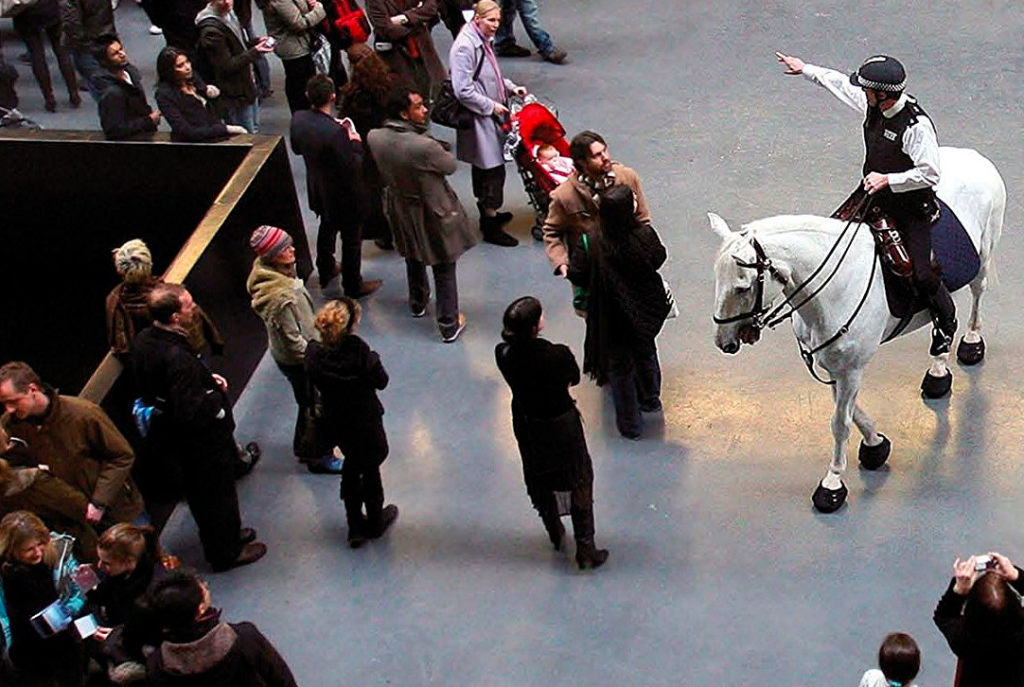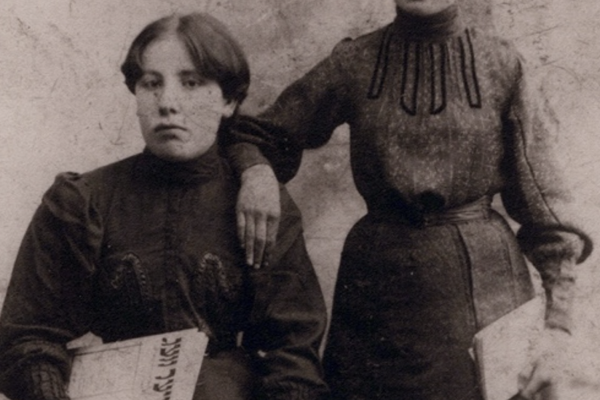What problems arise when governments use art as a substitute for political engagement? In her new book Artificial Hells: Participatory Art and the Politics of Spectatorship, Claire Bishop raises this question while tracing the historical role of participatory art. Called “social practice” in the United States, this type of collective art arose in the twentieth century as part of a new avant-garde approach in which the audience shares in the creative process as active participants, often with a larger political purpose in mind. In one well known performance piece, The Battle of Orgreave, artist Jeremy Diller re-enacted a 1984 British miner’s strike. Bishop argues that as the movement has spread throughout North America and Europe and as governments and institutions have embraced it, the need has grown for a new critical vocabulary to address it. In doing so, she says, we must pay special attention to the relationship between art, on the one hand, and politics, ethics, and aesthetics, on the other. I interviewed her by phone last week.
Corinne Segal: What made you want to explore this topic?
Claire Bishop: I came to it by noticing the prevalence of this kind of work in Northern Europe, where it’s called “socially engaged art” or “participatory art” (as opposed to “social practice” in the United States). It has received extensive support and funding, and made great claims for creating community, empowering people, and repairing the social bond. It’s also a non-market-oriented art that has avoided strong visual statements and operated in an avant-garde tradition of ameliorating society. At the same time, I was dissatisfied with the critical discourse around this work—the kind of uncritical claims being made about it deviated from my experience of these projects.
I think anyone who’s interested in art’s relationship to politics and society needs to engage with this kind of work, which, as you can tell from the term “social practice,” is interested in treating society as its material. In fact, it’s telling that the term “social practice” doesn’t even have the word “art” in it anymore. The phrase “social practice” seems rather to draw its currency from law, or from medicine—professions that we refer to as “practices.” This seems to cry out for analysis.
CS: In what ways is our discussion of this type of art currently flawed? Is it a problem that it doesn’t seem to be perceiving itself as an art form?
CB: Partly, to the extent that social practice, despite denying its artistic character, circulates almost exclusively in art institutions and receives the bulk of its funding from them. So there seems to be a blind spot. Why does this work not want to be conceived as visual art? One obvious answer is that the art market is so dominant and devalues anything experimental or oppositional; it’s understandable that artists don’t want to associate themselves with it. At the same time, this work circulates within art institutions and even has its own prizes and dedicated masters of fine arts programs. So it’s a paradox: we have an important strand of contemporary art that doesn’t want to be identified as art, and thereby risks falling out of public attention and out of history.
One of the main criticisms that I make in the book is that the discussion of social practice has developed around a set of ethical criteria: has the artist behaved well toward his or her participants? Does the work offer a good model for society? At the moment, good intentions are viewed as sufficient to make a fine work of art. This produces an overly earnest framework for discussing art, as well as projects that are safe, timid and predictable—organizing film screenings, going for hikes, cooking meals, and so on. This approach precludes the appreciation of other productions, especially ones that are more aggressive, disturbing, or perverse; more indirect or subversive approaches to the social are dismissed as exploitative and excluded. But these more radical projects might be telling us something more truthful and honest about social relations. This ethical perspective tends to infantilize participants, presuming they are unable to make their own judgments about a work.
CS: Is there any way to judge which of those two methods—the ethical approach and the sensory approach, in which you base the artistic value of art on experience of it—is more effective in analyzing social practice, or a piece of art in general?
CB: Let’s sidestep the question of efficacy for a minute. My whole book is about trying to overcome this polarity of either/or: either ethical criteria or artistic criteria. I want to find a new way of thinking that allows the artistic and the political to interpenetrate each other without both becoming subservient to what [Jacques] Lacan calls the “big Other” (in other words, thinking what we think other people want us to think). In prioritizing artistic and political judgments, I’m not throwing out an ethical position (because at the end of the day ethics underpins all political beliefs), but simply reducing its importance for analyzing art. I want to encourage a double analysis, whereby we deal with these projects both as works of art and as social interventions.
CS: Speaking a little more to the political experience of art, you examine in your book the position of social practice in relation to certain political upheavals and shifts in history. I wanted to ask you if art is inextricably linked to the political climate. Could you speak a little bit to how one may affect the other?
CB: I chose case studies for the book where the connection between artistic innovation and political context was particularly strong. By doing this research, I learned that it was during moments of political upheaval—1917, 1968, 1989—that artists intensely questioned the function of an artist and the function of a work of art. So this connection is definitely emphasized in my book.
But as for art in general, and whether it’s inextricably linked to political climate, I think there are two takes on this. On the one hand, you can say that all art is political, even when it’s abstract or seems apolitical, because great art is always an implicit comment on the world, even if by means of negation. On the other hand, you can say that art is only political when society, the media, or politicians take notice and there’s public discussion or even a trial (as in the case of Pussy Riot). In other words, art is political only if it prompts public controversy. I think neither of these views is satisfactory; the former imputes too much agency to the work of art, and the latter to the context of its reception. Ideally we should always read art dually, in relation to its artistic context and to its political context. (This is why, unlike many art historians, I pay attention to cultural policy.) This isn’t relativism, but a call for historical specificity.
Social practice’s identification with ethics and politics should lead us to ask what’s prompting its allergy to the aesthetic.
CS: In the book, you discuss how participatory art can try to compensate for the shortcomings of policy. Tell me more about that.
CB: I began researching and writing this book in the United Kingdom, where New Labour introduced cultural policies that privileged participatory art as a way of creating the appearance, but not necessarily the reality, of social cohesion. If you have a work of art that shows several hundred people participating, especially in a run-down area, it looks good. It creates the impression of community. This doesn’t mean that excellent works of art can’t result from such policies, but we should be aware of the profound disconnect between this cultural policy and New Labour’s actual social policies, which furthered the Thatcherite project of dismantling social services, creating a two-tiered health care system, and exacerbating a two-tiered educational system. When you look at works of art in this context, it changes your understanding of their “politics”: you see how culture is being used as a cost-effective way of creating the impression of social cohesion, while covering up policies that are actually undermining it.
Since the conservative-liberal coalition came to power in 2010, the relationship between art and cultural policy has changed. The current state of participatory art is one that reflects [Prime Minister] David Cameron’s belief in the “Big Society”— the idea that everyone will pitch in and contribute toward making society better. It’s an expedient slogan for a political project of withdrawing state support for community centers, libraries, post offices, education, and so on. The character of participatory art today seems to be in keeping with Cameron’s culture of volunteerism. You see this is in many of works for the Cultural Olympiad—a huge cultural program that accompanied the Olympics. There’s a lot of participatory work that depends on the goodwill of unpaid volunteers.
CS: Can you think of an example of that?
CB: The artist Marc Rees has turned some aircraft fuselage into a mobile art space that is touring around Wales, where local community groups are being asked to provide the content for this mobile gallery. In Scotland, another artist, Craig Coulthard, has made a football pitch in a forest that needs to be “activated” by amateur teams, who wear strips designed by local children. In both cases, artists supply an infrastructure that depends upon communities becoming content-providers.
CS: That’s very interesting; I don’t think I’ve observed something like that before at the Olympics.
CB: At the same time, the main artistic icon of the London Olympics was a grotesque Anish Kapoor sculpture outside the main stadium, made from £19 million of monstrous, contorted steel. It looks like [Vladimir] Tatlin on crack. This is the epitome of art under the Conservative-Liberal coalition: an overinflated celebration of Lakshmi Mittal, the private individual who funded 85 percent of its construction and after whom the sculpture is named.
CS: Speaking of aesthetic judgments, I wanted to read a quote from your book. You write that the philosopher Jacques Rancière believed that “Aesthetics and politics overlap in their concern for the distribution and sharing out of ideas, abilities and experiences to certain subjects.” However, some artists, especially in social practice, have begun to think of the whole idea of aesthetics as dangerous and not a useful tool in the analysis of art. What role does the aesthetic play, in your opinion?
CB: The first thing to stress is that the “aesthetic” as used by Rancière is not about a formal appreciation of the beautiful. For Rancière it is a regime of experience in which we perceive works of art—a regime that was inaugurated by the Enlightenment and that persists today and accommodates anything and everything that goes under the name of art, including the most anti-aesthetic practices. Rancière’s idea of aesthetics is very relevant to an analysis of social practice, because it allows us to deal with the paradoxes of this anti-aesthetic work, and to shuttle between the artistic and the political.
CS: Is the aesthetic being crowded out right now by these more political considerations of social practices?
CB: Of course from a market perspective, social practice is still very marginal, so there is no question that the aesthetic (in the old sense of the word, as something visually appealing) is still rife, adorning collectors’ homes everywhere. So I don’t see social practice as influential enough to crowd out the aesthetic in contemporary art. But social practice’s identification with ethics and politics should lead us to ask what’s prompting its allergy to the aesthetic. I’ve already mentioned the art market as a system with which many artists do not identify; this represents a bigger problem, which is a widespread dissatisfaction with free market capitalism and the inequality and disempowerment it produces. I think social practice also says something about our relationship to technology. I don’t think it’s a coincidence that social practice arises simultaneously with the digital revolution. Face-to-face relationships are becoming important as we spend more and more time online.
CS: In what way will our discussion of social practice, and your discussion of it in the book, help shape conversation in the future? Do you see any kind of reconsideration taking place?
CB: Well, this is the ninety-million-dollar question. First, I would like artists and curators to feel able and willing to criticize this work. When there’s a lack of critical self-examination, you leave yourself vulnerable to other people’s agendas. The fate of community arts in the ’70s should be a warning here: rather than being a vehicle for dissent and empowerment, they became a cost-effective way of mopping up where social agencies were lacking.
I’d also like the book to question the use of political art as a substitute for political engagement. There is a widespread belief in the art world that art is the last remaining space of opposition. This attitude is part of the problem rather than part of the solution. Moreover it’s insulting to all those who campaign tirelessly for social and political change. Works of art can lend support and momentum to larger political projects, but they can’t instantiate major change by themselves.








